This lemon buttermilk cake is tender and ultra-moist. The center layer has easy homemade lemon curd, and the final touch is a a cream cheese frosting that is the perfect balance of tart and sweet. I also share a few tips I’ve learned, over the years, to make scratch cake baking more successful!

I’ve often said that if given a choice between chocolate cake or lemon cake– lemon for the win! So, when a friend and I decided to split a slice of lemon cake at a local restaurant we both commented that the cake was really dry. The only redeeming factor for the disappointing cake was the cream cheese frosting. By rationing enough frosting for each bite, we managed to finish the cake– and not waste it. Honestly, the cake wasn’t awful. It’s such a shame when a baker over bakes a cake that has so much promise!
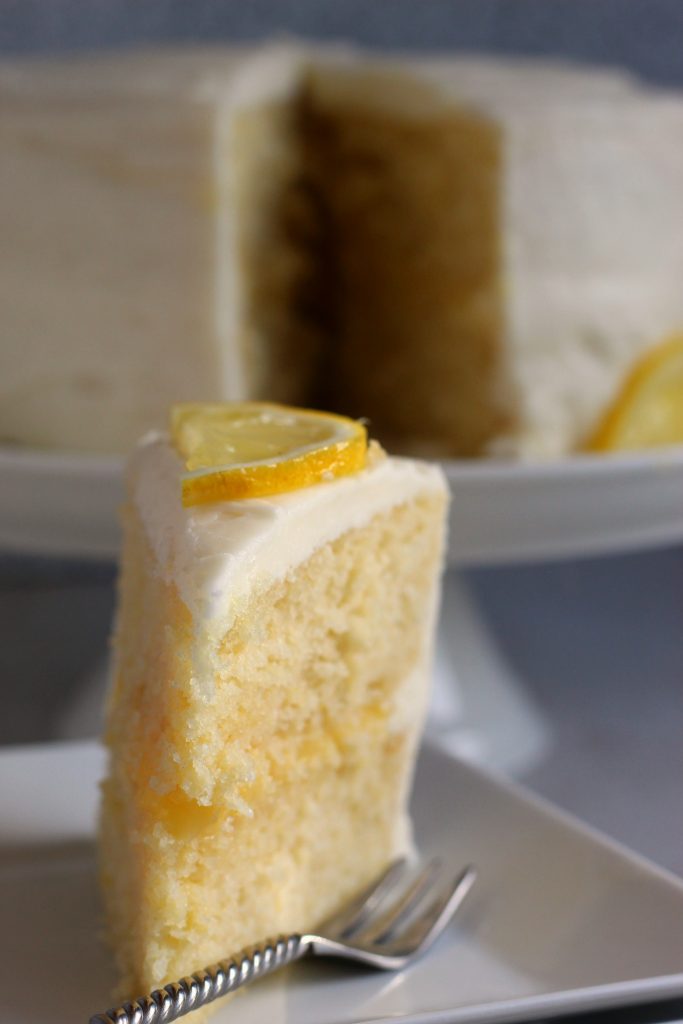
I’ve been baking cakes ever since I was a little girl. My mom would buy boxed cake mixes and for most of my young adult life, that’s how I baked cakes. Cake mixes are fool-proof and they do taste good. Making a cake from scratch is a fear I needed to conquer. As an additional shortcut, I bought canned frosting (shudder)– until I finally learned how easy it is to make buttercream from scratch. Nowadays, I can immediately tell if cake frosting came from a can because it tastes artificial to me. Have you ever looked at the ingredients in canned frosting?! Trust me, please, that while canned frosting is a cheap shortcut, homemade buttercream is so much better and super easy to make.
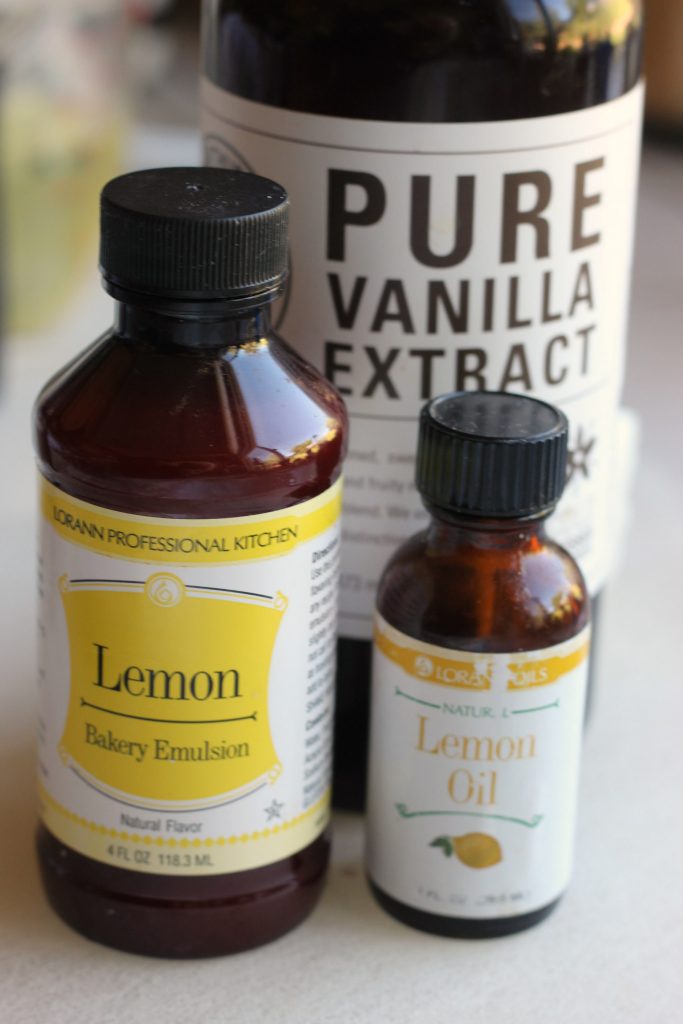
Over the years, I’ve built up pantry baking ingredients that might cost a little more, but I find that they are worth it. I buy only pure vanilla and never imitation vanilla. I have nothing against flavor extracts, and I have some in my pantry. Instead, I gravitate more towards baking emulsions and pure lemon or orange oils because they also give a more intense flavor. If you want to stick with traditional extracts, no harm no foul.

Learning how to prepare cake pans, so your cake doesn’t stick is something I have finally mastered for myself. Back in the day, I did the “butter and flour” technique. A few years ago, I discovered “Baker’s Joy” spray and it has never failed me. Pre-cut parchment paper is a shortcut that I think is well worth the investsment. I buy them in 8″ and 9″ rounds, and in baking sheet sizes. Just grab one, and set on top of a prepared baking pan. Baking strips is another baking tip that helps me my cakes to not develop that dome topping that you have to learn to cut with a cake leveler. Pictured here are older ones, that you have to wet and close with a pin– these fit around my 8″ pans. I much prefer the silicone baking strips, but they only fit my 9″ cake pans. (Later on, you’ll see how these truly work.)
Okay, the oven is preheating to 325F and it’s time to make the cake batter. There are lot of great hand mixers out there. For me, my stand mixer is one of my most prized kitchen tools. No matter what, I’ve learned that you don’t want to over mix/over work cake batter. Unlike making bread, we don’t want to build up gluten = tough cakes.
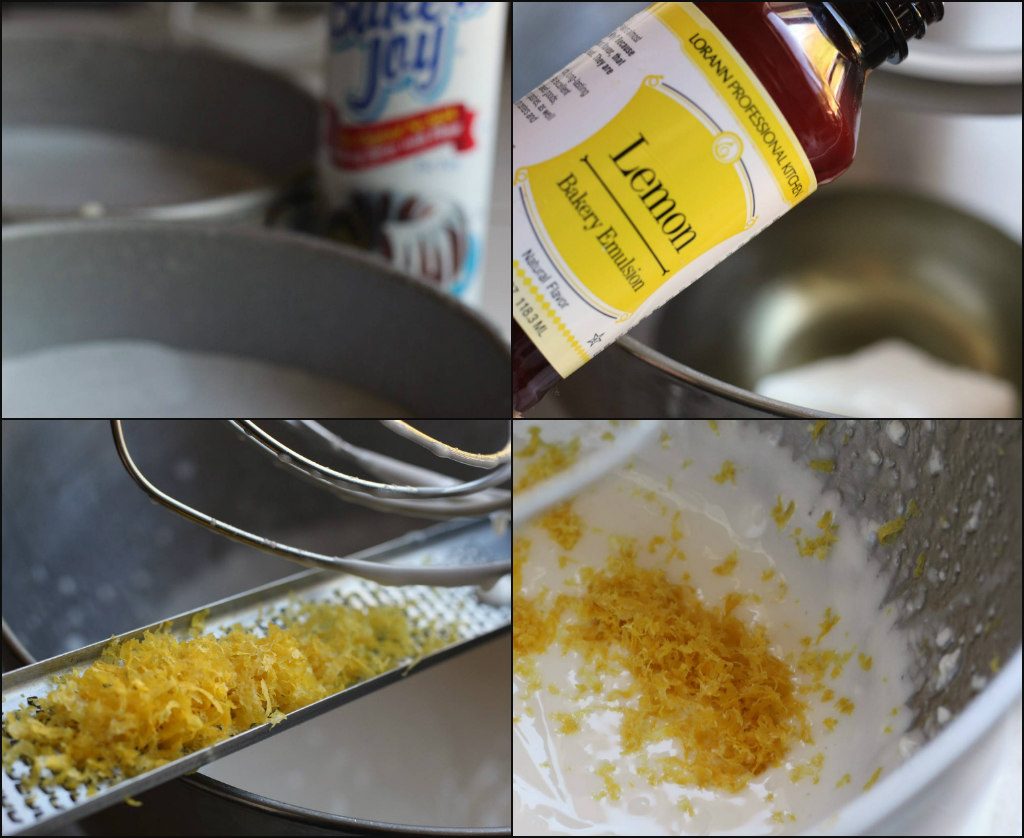
Since I’m making a lemon cake, I’ve got lemon zest to along with the lemon extract (or baking emulsion and lemon oil). This recipe is a little different– using the whisk attachment, I creamed vegetable oil, a little shortening, and my extracts until it’s all combined.
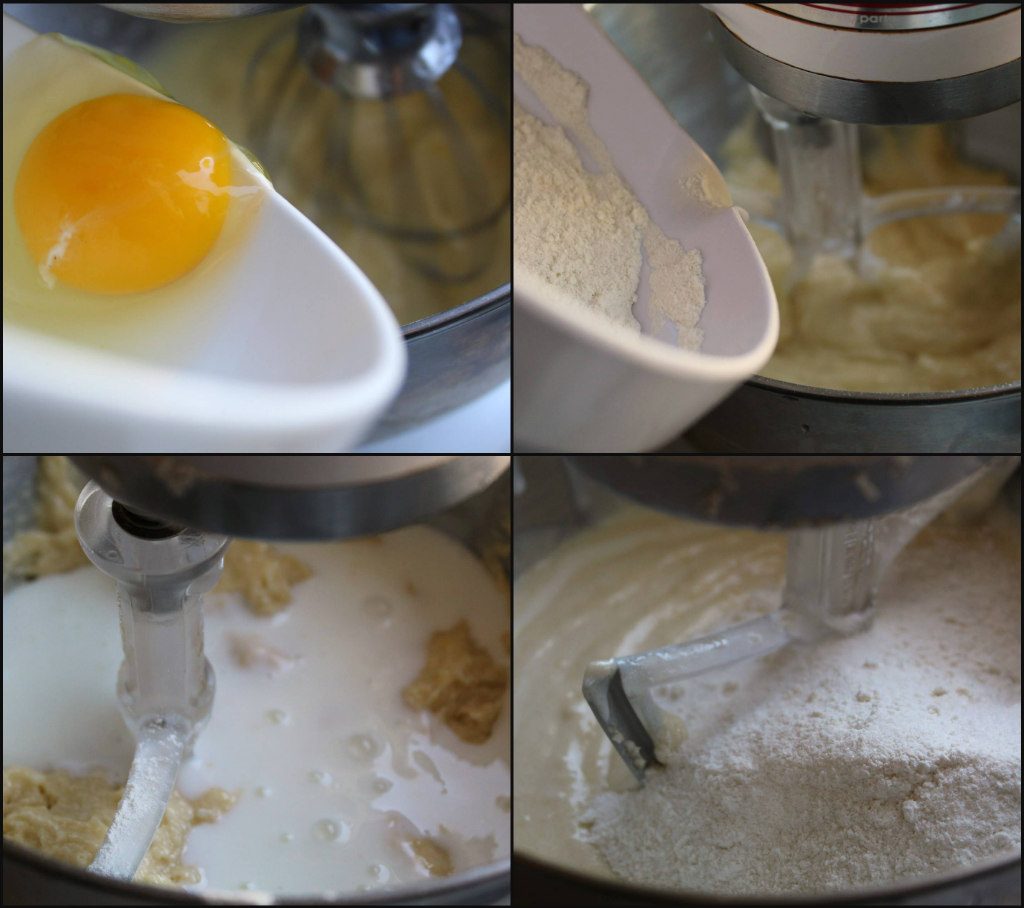
I’ve sifted together my dry ingredients– flour, sugar, leaveners etc. I begin by adding about 1/3 of my dry ingredients and then “pulse” the mixer in short bursts to gently mix together. Then, I added half the buttermilk and pulsed until combined. Add dry, add buttermilk and finish with dry. All the while, the mixer isn’t continuously running– so that I stick with my “don’t over mix rule”. Done!
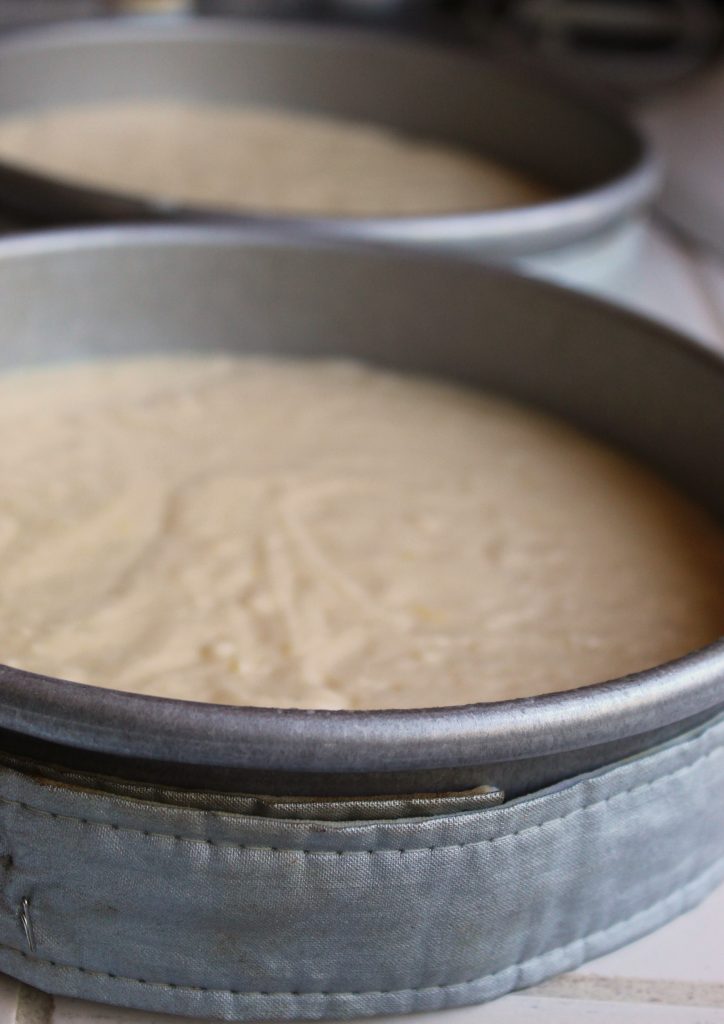
I’m not gonna lie. I don’t weigh my pans to scientifically split the dough evenly into the prepared pans. I “eyeball” it. Another trick I’ve learned is to lift each pan a few inches off the countertop and then to drop it on counter. Smack! (The idea is to release any air bubbles.) Sometimes, I spin each pan as well. It doesn’t take but a few seconds so I’m faithful with that baking technique that I learned from watching the pros on cooking shows.
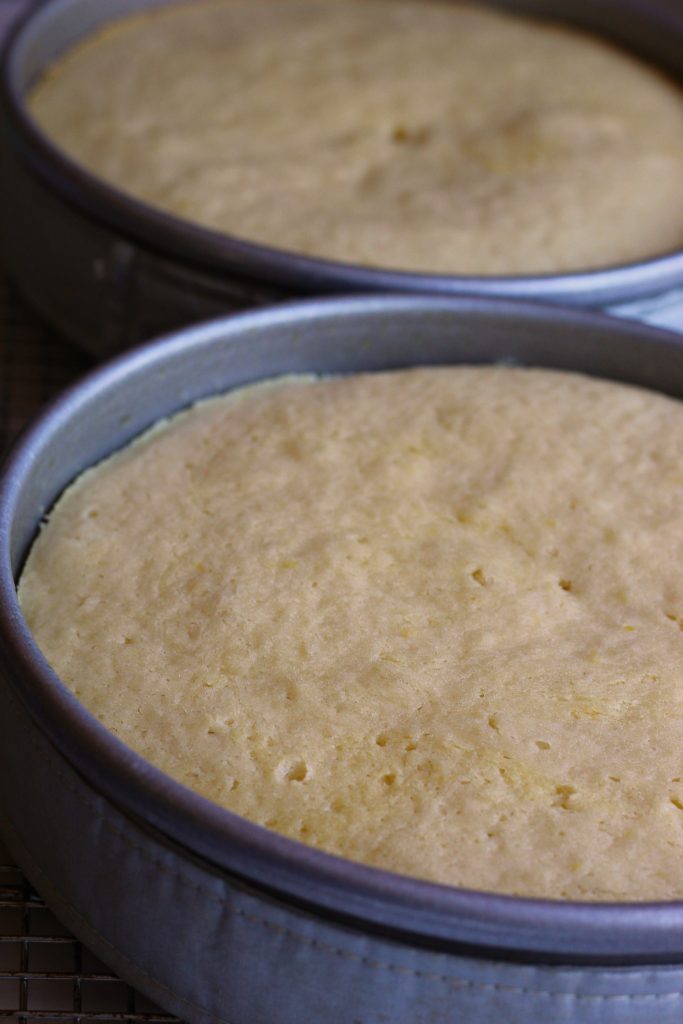
So, let’s talk about baking times. Every oven is different. This recipe said to bake for 30-35 minutes. I always set a timer for 5 minutes less than the minimum time listed. I can always bake longer, but once I’ve overdone it– too late! I used 8″ pans, because I wanted taller cake layers. As it turned out, the cakes passed the “toothpick test” (just a few crumbs clinging to it). See what I mean? There are no dome topping. I swear by cake baking strips! I set the cakes on a wire rack to cool.
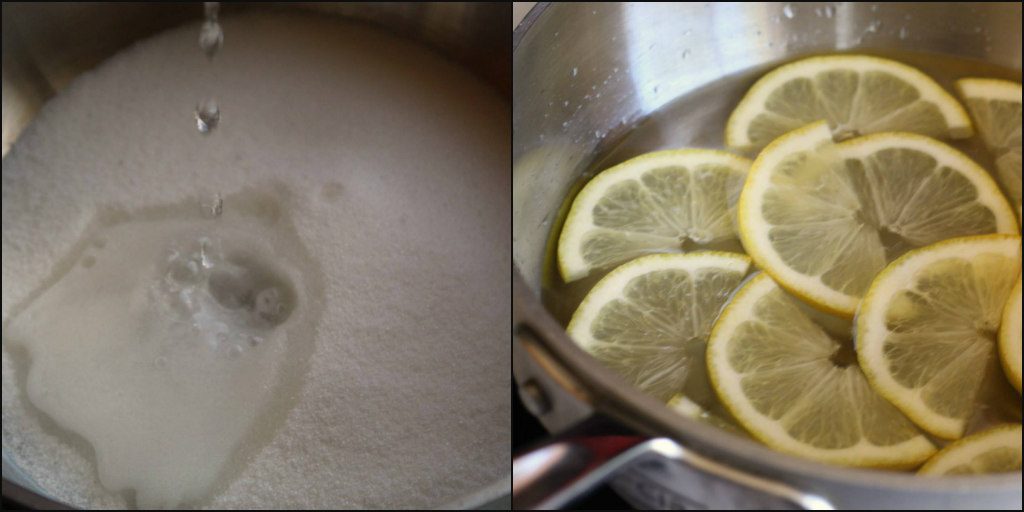
On a whim (since our lemon tree has been very generous with fruit) I thinly sliced up a lemon and made a mixture of 1 cup sugar and 1 cup water. Once the sugar has thoroughly dissolved, I brought the lemon slices to a simmer and then let them cool.
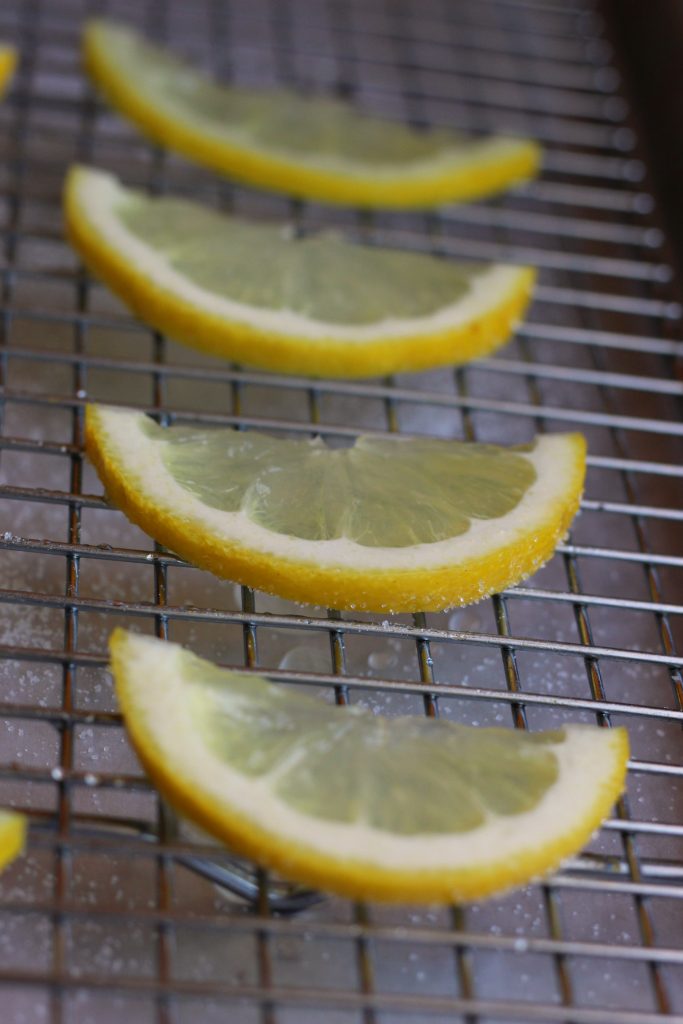
Here they are, on a wire rack with sugar sprinkled on both side. NOTE: I’m not including these in my recipe card because they are completely optional for decoration. (I did save the lemon flavored “simple syrup” for future recipes.)

Cream cheese frosting is very simple to make. I used unsalted butter and a package of cream cheese, very soft at room temperature. For flavoring, I added pure vanilla and lemon oil, plus fresh lemon juice (instead of milk). I kept adding one cup of powdered sugar at a time, until the frosting reached my desired consistency (7 cups total). I wanted to pipe my frosting, so that’s the texture I was going for.
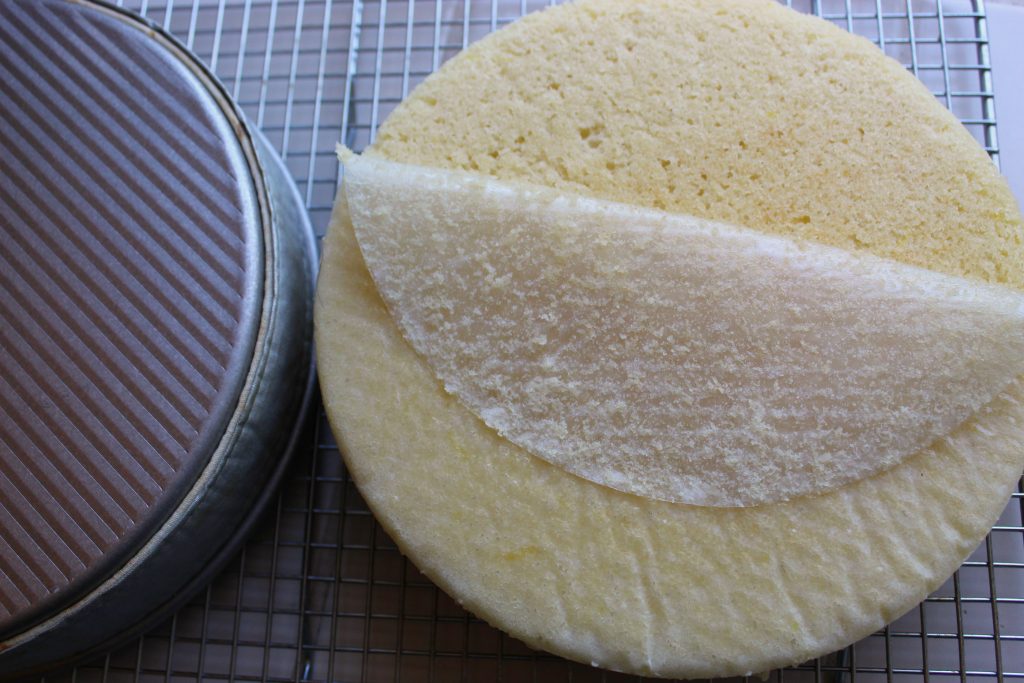
So, here we are. I set the cooled cakes on top of a wire rack, and set another one on top– and, very carefully, I filled the racks over. Voila! The cake pans lifted right out! I peeled off the parchment paper and it was time to frost the cake.
Trust me– fancy piping and frosting skills is something I work on every time I bake a cake. It takes practice, tools and a little courage and perseverance. One of my best investments was to buy a rotating cake stand. This one is super sturdy and came with all kinds of cake tools that I’ve put to good use– for less than $30 for the whole kit and caboodle!
I won’t get into showing you how I fill my piping bag etc. as there are countless free videos on YouTube that will show you how. (I learned by taking a cake decorating class at my local “Michael’s” Craft Store.)
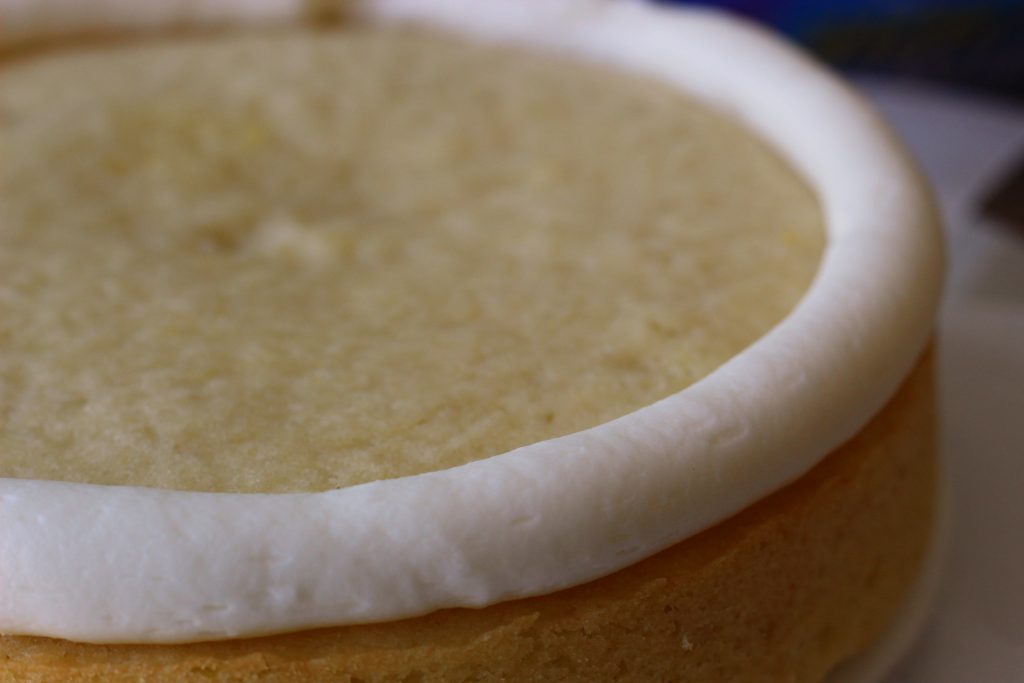
Since I had foolproof homemade lemon curd, in my fridge, I decided to pipe a “dam” of frosting so that the curd wouldn’t fall over the edge of the layer.

I used a little over a cup of lemon curd and spread it with an offset spatula (another valuable baking tool).

I set the top cake layer upside down so I’d have a perfectly flat top. Done! NOTE: Yes, I see a lot of “holes” in the cake. That’s the beauty of frosting. It’s our little secret, yes?
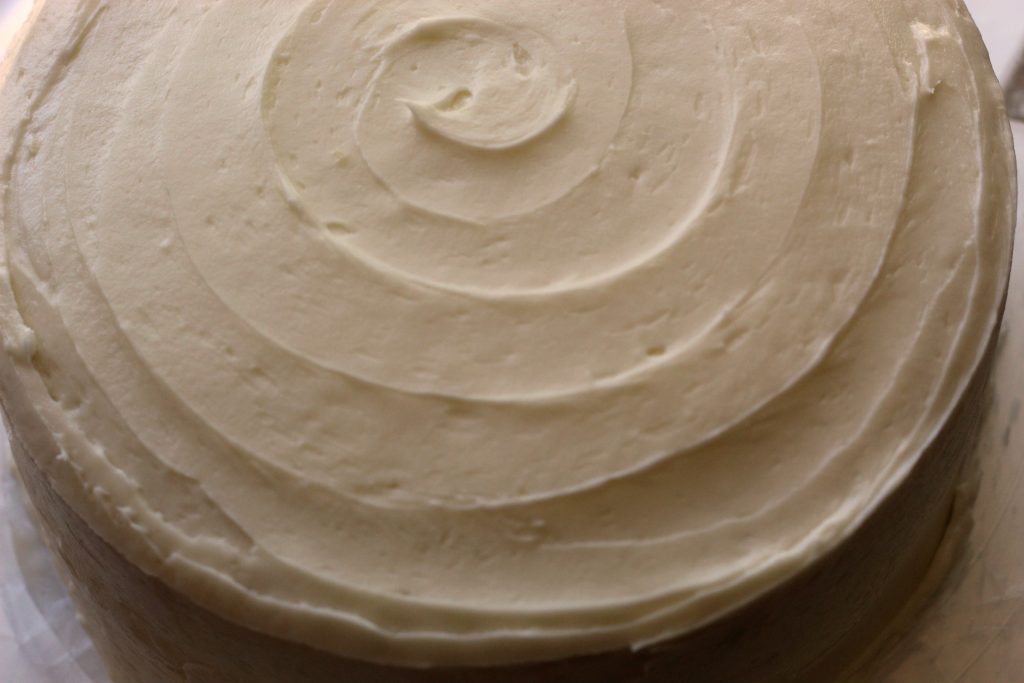
Using an offset spatula, I gave the cake stand a spin and got this fun pattern on top. See? I’m starting to experiment a bit more!
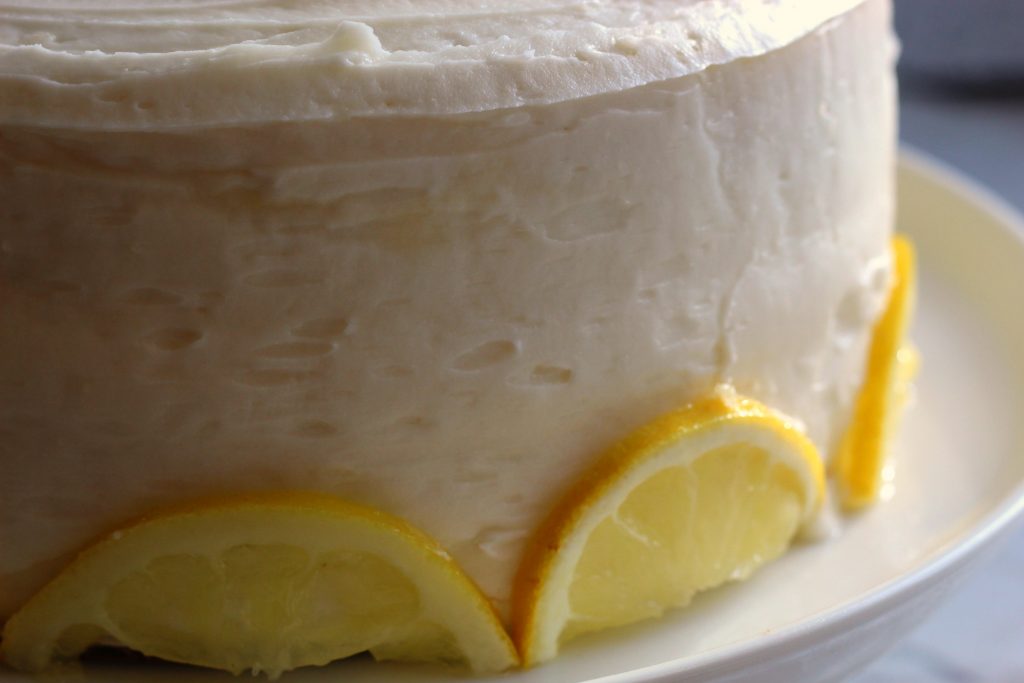
…about those sugared lemon slices. They were soft and pliable and after deliberating for 30 seconds, I added them as a decoration. Truthfully, next time I’ll make candied lemon slices (more time-consuming)– since I noticed that nobody actually ate them. They’re kind cute, though!
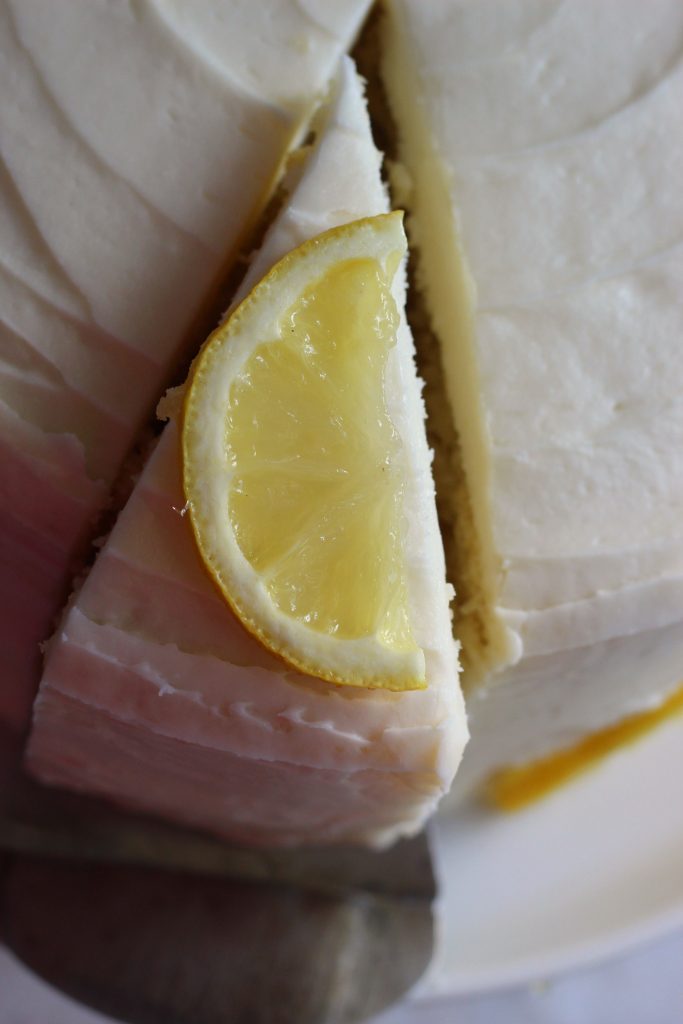
We had dinner guests, and it was time to slice into the cake. I always find this is the moment that my hopes are off the charts.

Picture this: folks standing over me, while I’m trying to take a photo and natural light is starting to fade. There were some ooh’s and ahh’s and now that I think back, I think those came from me! I’m very pleased!
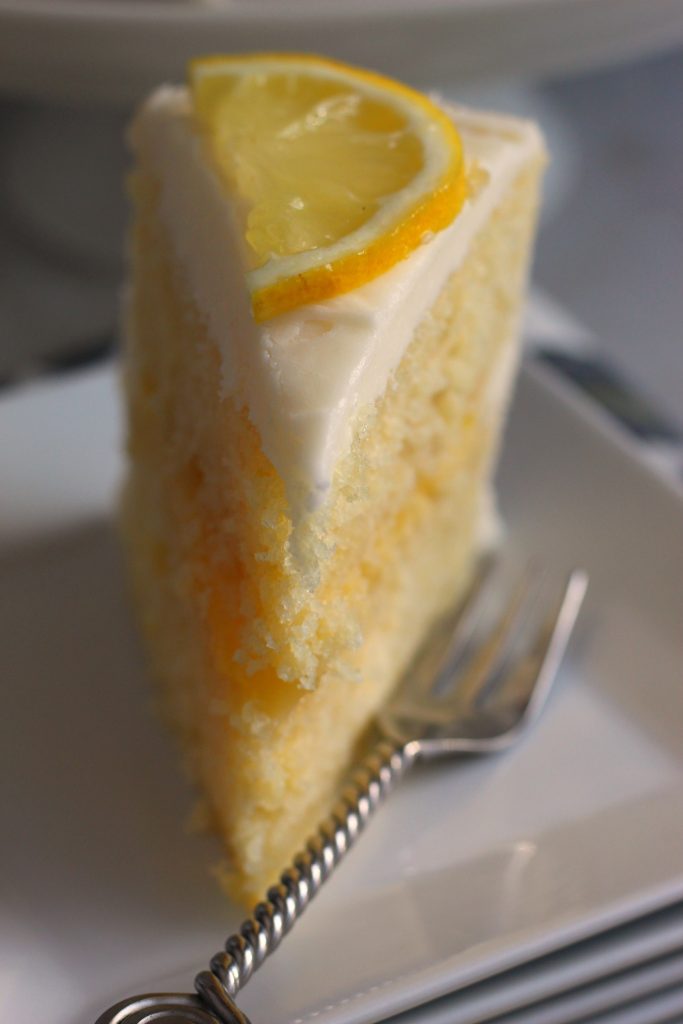
TASTING NOTES: Is the cake moist? Heck ya! How can you go wrong with buttermilk and vegetable oil?! The lemon curd in the middle really brought home that lemon flavor I was hoping for. As for the frosting– the tang from the cream cheese enhanced the lemon flavor, without being sour. The frosting is not cloyingly sweet.

Half of the cake is already gone, once our guests departed. I’m going to cut the remaining half into slices, wrap them tightly in plastic wrap and freeze them in a large ziploc bag. Frozen cake takes little time to thaw, and that should help me to resist the temptation to eat this for breakfast, lunch and dinner. I’m very, very pleased with how this cake turns out so this one becomes one I’d definitely make again.
Bottom line– I invite novice bakers (like me) to experiment and to practice how to make bakery quality cakes. I visit a lot of popular cake baking food blogs and I’m always impressed with their cake baking chops. I’ll get there, though I’ve truly come a long way from those days of cake mixes and canned frosting. At least I think so! I do know that dry and over baked cakes don’t happen in my kitchen any longer and that is a very good thing.
Lemon Layer Cake with Lemon Curd and Lemon Cream Cheese Frosting
Ingredients
- 1 1/4 cups all purpose flour
- 1 1/2 cups cake flour sifted
- 1/2 teaspoon baking soda
- 1 1/2 tsp baking powder
- 1 tsp salt
- 1 1/2 cups sugar
- 2/3 cup vegetable oil
- 1/3 cup vegetable shortening room temperature
- 1 tsp vanilla extract
- 2 tsp pure lemon extract I used 1 tsp of pure lemon oil, and 2 tsp of Lorann Lemon Baking Emulsioninstead
- 3 large eggs room temperature
- 1 1/2 cups buttermilk room temperature
- 1 Tbsp lemon zest (average amount from one lemon); reserve the lemon for the frosting
For the Frosting
- 1 package cream cheese 8 ounces, softened
- 1 stick unsalted butter softened
- 7 cups powdered sugar see recipe notes
- 1 pinch salt
- 1 tbsp lemon juice (average juice of one lemon)
- 1 tsp pure lemon oil you can use lemon extract; optional, recommended Lorann Lemon Oil
- 1 tsp pure vanilla extract
- 1 cup lemon curd (optional) homemade or store-bought; see recipes notes for homemade curd recipe
Instructions
Prepare the baking pans:
- Grease and flour 2 eight- inch round cake pans (see recipe notes for 9-inch pans). To prevent the cake from sticking, I use Baker’s Joy baking spray (see recipe notes). Spray each pan and line the bottom with 2 circles of parchment paper. Otherwise, prepare the pans with butter or grease and coat each pan.
For the dry ingredients:
- Sift together both flours, baking soda. baking powder, salt and sugar in a bowl; set aside.
- For the wet ingredients:
- Using the whisk attachment, in the bowl of a stand mixer (or hand mixer) beat the vegetable oil, shortening, vanilla and lemon extract (or Lemon emulsion and lemon oil. Beat well at high speed with whisk attachment until light and fluffy.
- Add the eggs, one at a time, until combined.
Making the cake batter:
- Fold in the lemon zest. With my stand mixer, I simply “pulse” on the lowest setting until combined.
- Fold in the dry ingredients alternately with the buttermilk.NOTES: The trick to tender cakes is to alternately add the dry ingredients and wet ingredients. Start by adding the dry ingredients. I use a Kitchen Aid Stand mixer, with a beater blade and using the lowest setting, I quickly turn the power on and off– this mimics folding in the batter and doesn’t overwork the dough. The order I use is to add the dry, pulse to combine; add half the wet, pulse to combine, add the rest of the wet, pulse to combine; finish with the rest of dry. Using a spatula, scrape the bowl and make sure all of the ingredients are combined.
- Add half of the batter to each prepared cake pan. Lift each pan a few inches off the kitchen counter and drop (to release any air bubbles).
- Bake at 325 degrees F for 30-35 minutes or until a wooden toothpick inserted in the center comes out clean.NOTES: Please keep in mind that all oven temperatures can vary.Whenever I bake cakes, I set a timer for 5 minutes less than the minimal baking time listed to avoid accidentally over baking my cakes. Since I used two 8-inch pans, my cakes were ready in exactly 35 minutes.
- Allow the cake to cool in the pans for 10 minutes before turning out onto wire racks to cool completely.
For the frosting:
- Beat together the softened butter and cream cheese until creamy.
- Add the salt, lemon juice and vanilla until combined.
- Add the powdered sugar, once cup at a time. Depending on how you plan to use the frosting the desired thickness is important. I wanted to pipe the frosting, so I used all 8 cups for a thicker frosting.
Layering the cake:
- The safest way for me to remove cakes from a pan is to set them on top of a wire rack, then set another wire rack on top. Carefully flip the cakes over so that the pans are now on top. If the cake pan has been properly prepared, the cakes will come right out. Peel away the parchment paper.Set the other wire rack back on top, and flip the cakes over.
To frost the cake:
- It takes a some time and practice to make cakes look bakery professional (I’m still working on perfecting that). If you have a rotating cake stand, Set one cake layer on top. I fill a piping bag by “eyeballing” about 2 cups of frosting (I can always return the rest to the frosting bowl) and I use a large round-tip to pipe along the edge creating a dam). Inside that “dam” I add about a cup of lemon curd and spread it with an off-set spatula. If you choose not to use lemon curd, then spread about a cup of frosting as the middle layer.
- Frost the top and sides of the cake. A rotating cake table makes this much easier to do. I use a “bench scraper” and spin the cake to create soft even sides. Or, just frost the way that you feel most comfortable doing– there is no right or wrong way!
- Chill the cake for at least an hour, for the frosting to set.
Notes
- Parchment paper
- Baker’s Joy Non-Stick spray (my cakes always come out)
- Cake bands (to prevent “doming” of cake and allows more even baking
- Recommended lemon oil (prefer this over Lemon Extract): Lorann brand
- My favorite ingredient to add more flavor into baked goods: Lorann brand baking emulsions
Nutrition



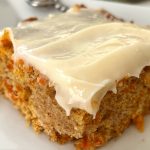
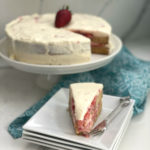

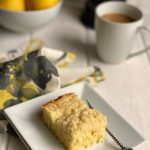
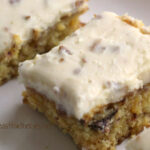
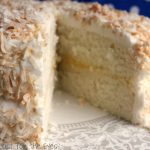
So many valuable tips besides a delicious cake recipe…thank you.
Thank you, Karen!
Can you send me your Recipes?
There is a printable recipe card at the end of the post!
Did I miss the note on using 9-inch pan somewhere? Thanks!
Thank you for asking. No, you didn’t miss it. I did! I added the note that a 9″ cake pan will bake faster, so be sure to check about 5 minutes earlier.